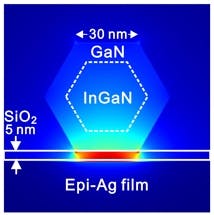Smallest semiconductor laser created by University of Texas scientists
Austin, TX--Physicists at the University of Texas at Austin, in collaboration with colleagues in Taiwan and China, have developed the world’s smallest semiconductor laser. The scientists report their efforts in this week’s Science.
Miniaturization of semiconductor lasers is key for the development of faster, smaller and lower-energy integrated photonics; highly sensitive biosensors for detecting, treating and studying disease; and next-generation optical communications devices.
Until now, the size and performance of photonic devices have been restricted by the 3D optical diffraction limit. "We have developed a nanolaser device that operates well below the 3D diffraction limit," says Chih-Kang "Ken" Shih, professor of physics at the University of Texas. "We believe our research could have a large impact on nanoscale technologies."
The laser is continuous-wave, low threshold, and emits green light. It is constructed of a gallium nitride nanorod partially filled with indium gallium nitride. The nanorod is placed on top of a thin insulating layer of silicon that in turn covers a layer of silver film that is smooth at the atomic level.
It’s a material that the Shih lab has been perfecting for more than 15 years. That "atomic smoothness" is key to building photonic devices that don’t scatter and lose plasmons.
"Atomically smooth plasmonic structures are highly desirable building blocks for applications with low loss of data," said Shih.
Nanolasers such as this could provide for the development of chips where all processes are contained on the chip, so-called “on-chip” communication systems. This would prevent heat gains and information loss typically associated with electronic devices that pass data between multiple chips.
"Size mismatches between electronics and photonics have been a huge barrier to realize on-chip optical communications and computing systems," says Shangjr Gwo, professor at National Tsing Hua University in Taiwan and a former doctoral student of Shih’s.
Shih and Gwo’s colleagues include Gennady Shvets, professor of physics at The University of Texas at Austin, and Lih-Juann Chen, professor at National Tsing Hua University.
For more information, contact Ken Shih at [email protected].

John Wallace | Senior Technical Editor (1998-2022)
John Wallace was with Laser Focus World for nearly 25 years, retiring in late June 2022. He obtained a bachelor's degree in mechanical engineering and physics at Rutgers University and a master's in optical engineering at the University of Rochester. Before becoming an editor, John worked as an engineer at RCA, Exxon, Eastman Kodak, and GCA Corporation.
